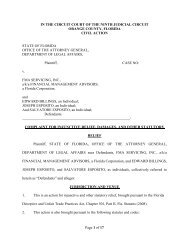Roman Pino v. Bank of New York Mellon - Fourth District Court of ...
Roman Pino v. Bank of New York Mellon - Fourth District Court of ...
Roman Pino v. Bank of New York Mellon - Fourth District Court of ...
Create successful ePaper yourself
Turn your PDF publications into a flip-book with our unique Google optimized e-Paper software.
In Select Builders the plaintiff obtained affirmative relief by the granting <strong>of</strong>the suspect injunction, and it had obtained such relief by fraud. Comparingthe facts <strong>of</strong> Select Builders to this case, we find that the BNY <strong>Mellon</strong> had notobtained any type <strong>of</strong> affirmative relief. Even if the assignment <strong>of</strong> mortgage was“fraudulent” in that it was not executed by the proper party, it did not result inany relief in favor <strong>of</strong> BNY <strong>Mellon</strong>. Select Builders is thus distinguishable fromthe present case. In Bevan v. D’Alessandro, 395 So. 2d 1285, 1286 (Fla. 2dDCA 1981), the court likewise distinguished Select Builders on the groundsthat the “plaintiff had received affirmative relief to which he was not entitledand sought to avoid correction <strong>of</strong> the trial court’s error by taking a voluntarydismissal.” No such circumstance is present in this case.The appellant argues that rule 1.540(b) also provides a method to seek relieffrom a notice <strong>of</strong> voluntary dismissal. We disagree that the defendant/appellantmay utilize that rule where the defendant has not been adversely affected bythe voluntary dismissal. Rule 1.540(b) allows a court to relieve a party from a“final judgment, decree, order, or proceeding” based upon any <strong>of</strong> five groundsset out in the rule: (1) mistake, inadvertence, surprise, or excusable neglect; (2)newly discovered evidence; (3) fraud or other misconduct <strong>of</strong> an adverse party;(4) that the judgment or decree is void; or (5) that the judgment or decree hasbeen satisfied or released. A notice <strong>of</strong> voluntary dismissal constitutes a“proceeding” within the meaning <strong>of</strong> the rule. See Miller v. Fortune Ins. Co., 484So. 2d 1221, 1224 (Fla. 1986). Therefore, the rule may be invoked, eventhough for all other purposes the trial court has lost jurisdiction over thecause. Id. Indeed, in Shampaine Industries, Inc. v. South Broward Hospital<strong>District</strong>, 411 So. 2d 364, 368 (Fla. 4th DCA 1982), approved by the supremecourt in Miller, we held: “Rule 1.540(b) may be used to afford relief to alllitigants who can demonstrate the existence <strong>of</strong> the grounds set out in theRule.”The rule, however, is limited to relieving a party <strong>of</strong> a judgment, order orproceeding. “Relieve” means “[t]o ease or alleviate (pain, distress, anxiety,need, etc.) . . . to ease (a person) <strong>of</strong> any burden, wrong, or oppression, as bylegal means.” The Random House Dictionary <strong>of</strong> the English Language 1212(1967). A defendant may obtain such “relief” when a plaintiff has obtained aruling that has adversely impacted the defendant. Here, the defendant has notbeen adversely impacted by a ruling <strong>of</strong> the court. The fact that a defendantmay have incurred attorney’s fees and costs is not an adverse impactrecognized as meriting relief. See Serv. Experts, LLC v. Northside AirConditioning & Elec. Serv. Inc., 2010 WL 4628567 (Fla. 2d DCA 2010).Therefore, because the defendant has not suffered an adverse ruling or impactfrom the notice <strong>of</strong> voluntary dismissal, he is not entitled to seek relief pursuantto the rule.4



